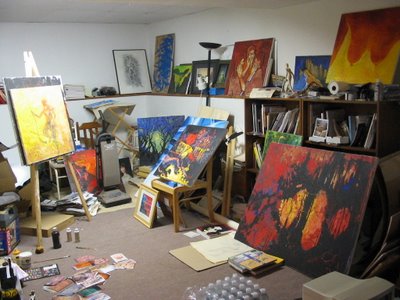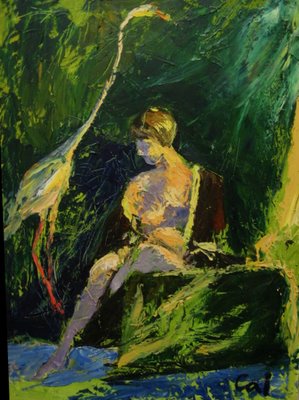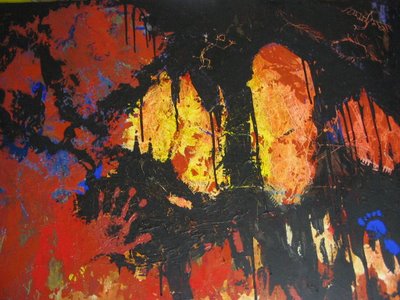Work achieve in NASA Scientific Visualization Studio:
http://visibleearth.nasa.gov/view_rec.php?id=14131
Saturday, September 30, 2006
Thursday, September 28, 2006
Hitchcock's Tales
From David Lloyd's interview:
...If James Stewart in Rear Mirror looked at the telescope, a woman fed a baby, then James smiled, then he is a gentleman. If the sequence is that James looked at the telescope, a girl wore bikini, then James smiled, then he is a naughty man...
watching scary movie is like dipping a finger into a cool water of fear...
blue food: blude fish, blue soup, blue bread...
What's your next movie? I am looking for the next body...
To highlight the poison milk glass, I put a light inside the milk glass...
Dear Mr. Hitchcock,
Since my daughter saw your film Psycho, she won't take shower anymore. She became unpleasant person. What we shall do?
Dear Sir,
Bring her to dry cleaner.
Hitchcock
...If James Stewart in Rear Mirror looked at the telescope, a woman fed a baby, then James smiled, then he is a gentleman. If the sequence is that James looked at the telescope, a girl wore bikini, then James smiled, then he is a naughty man...
watching scary movie is like dipping a finger into a cool water of fear...
blue food: blude fish, blue soup, blue bread...
What's your next movie? I am looking for the next body...
To highlight the poison milk glass, I put a light inside the milk glass...
Dear Mr. Hitchcock,
Since my daughter saw your film Psycho, she won't take shower anymore. She became unpleasant person. What we shall do?
Dear Sir,
Bring her to dry cleaner.
Hitchcock
Monday, September 25, 2006
Best Entertainers
Sunday, September 24, 2006
Happiness
"Don't aim at success -- the more you aim at it and make it a target, the more you are going to miss it. For success, like happiness, cannot be pursued; it must ensure...as the unintended side-effect of one's personal dedication to a course greater than oneself." - from Viktor Frankl, the Austrian psychologist, in the preface to his book, "Man's Search for Meaning"
"The positive aspects of human experience -- joy, creative, the process of total involvment with life call flow." "Happiness, in fact, is a condition that must be prepared for, cultivated, and defended privately by each person. People who learn to control inner experience will be able to determine the quality of their lives, which is as close as any of us can come to being happy." - from Mihaly Csikszentmihalyi's "Flow"
"The positive aspects of human experience -- joy, creative, the process of total involvment with life call flow." "Happiness, in fact, is a condition that must be prepared for, cultivated, and defended privately by each person. People who learn to control inner experience will be able to determine the quality of their lives, which is as close as any of us can come to being happy." - from Mihaly Csikszentmihalyi's "Flow"
Saturday, September 23, 2006
Friday, September 22, 2006
Ideas
“Don’t worry about other people stealing your ideas. If you’re ideas are any good, you’ll have to ram them down people’s throats.” -- Howard Aiken, IBM Engineer
It is a common practice in academic or industrial world that folks do steal ideas. I view the habit as a mental impotency and it is addictive. We are living in a creativity dafecit world. Sometimes, managers admitted to me in private that "I am too old. I don't have new ideas."
Watching people stealing ideas could be fun. Sometimes, people spread the half-baked ideas or wrong ideas to back to the source as 'new ideas' without understanding.
It is a common practice in academic or industrial world that folks do steal ideas. I view the habit as a mental impotency and it is addictive. We are living in a creativity dafecit world. Sometimes, managers admitted to me in private that "I am too old. I don't have new ideas."
Watching people stealing ideas could be fun. Sometimes, people spread the half-baked ideas or wrong ideas to back to the source as 'new ideas' without understanding.
Counter-Evolutionism
Just found a good example of the counter-evolutionism interaction design project: a typewriter that sends email:
http://www.interaction-ivrea.it/en/gallery/22pop/index.asp
well, there are many things we can do counter-evolutionism. But what for? If we say it's fine art, then that's OK. But product design? I don't know.
http://www.interaction-ivrea.it/en/gallery/22pop/index.asp
well, there are many things we can do counter-evolutionism. But what for? If we say it's fine art, then that's OK. But product design? I don't know.
Saturday, September 16, 2006
Mermaid
Monday, September 11, 2006
Road Wisedom
German carpenters are required to go abroad to study for three years before they can be profesional.
"lasai" - Spainish, 'relax', 'calm', or 'take it easy'.
"Sal a vie" - French, "That's life!"
"Shit happens!" - American movie "Forrest Gump"
"lasai" - Spainish, 'relax', 'calm', or 'take it easy'.
"Sal a vie" - French, "That's life!"
"Shit happens!" - American movie "Forrest Gump"
Friday, September 08, 2006
Visual Analysis of Human Dynamics
Visual Analysis of Human Dynamics: An Introduction to the Special Issue of Journal of Information Visualization, Vol.5, No.4, 2006
For thousands of years, visual expression of human dynamics has been a part of our life. Cave paintings revealed early human social networks in hunting activities. Architectures in Roman era encoded human anatomic proportions. Those artworks reflect the social and physiological aspects of human nature, from macroscopic to microscopic levels.
Today, rapid growing technologies such as Internet, mobile computing and sensor web have enabled new patterns of human interactions from social networks to physiological functions. Perhaps the best example is the rapid ‘evolution’ of our thumbs from holding to controlling mobile systems just in a few years recently. In parallel, the growing online communities enable the spreading of viruses and denying of services just like human physiological systems. As a result, human dynamics becomes more and more complex and vulnerable. Unfortunately, our understanding of the natural or social human systems is very limited. Many variables are invisible. To make invisible to be visible is the goal of visual analytics. Anomalous event detection and prediction have been the key tasks for both systems. We are living in an asymmetric environment, with continuous threats of varies cancers both at the microscopic and social levels. Einstein once said that nature is complex but not deceptive. Perhaps the key difference between a natural asymmetric system and a social asymmetric system is deception.
Computational visualization of human dynamics has been rapidly growing in recent decades. At the macroscopic level, the fundamental studies in social networks such as “the six degrees of separation” [Guare , 1999] and the “power law of the linked interactions” [Barabasi, 2002] shad lights on the scalability of human networking activities. Those remarkable models enrich our in-depth understanding of the dynamics in a very large network, which is a challenge to a visualization system. Spectrum-graph [Eagle and Pentland, 2005] is used to visualize human activities from ambient data sources such as gas stations and cellular phone towers. Graph models such as minimal graph cuts provide abstract, yet visual tools for analyzing the outliers in a very large social network [Chakrabarti, 2004]. Stochastic process based geographical profiling models have been developed to investigate serial killer’s spatio-temporal patterns from the collected field data [Rossmo, 1990]. Furthermore, the cellular automata based panic model simulates the mass dynamics in public places such as train stations. The method computationally incorporates modeling, rules and visualization in one algorithm, which enables emergent pattern discovery and rapid empirical experiments [Helbing, 2000]. In a nutshell, the paradigm of the visual analytic social networks has been shifted from merely visual data rendering to model-based visual analysis. However, a single model may not be a panacea as many researchers have claimed. The adaptability and interaction between models and visual interfaces are perhaps potential solutions.
At the physiological level, computational visualization of human dynamics has been growing exponentially. Decades ago, human motion studies were largely dependent on the time-lapped photography, where joints were highlighted to form motion trajectories. Today, digital motion capturing and modeling systems enable the high fidelity modeling of the motion characteristics. Functional MRI (fMRI) systems visualize human nerve and cardiac dynamics in real-time, which has revolutionized the way of physiological and psychological studies such as driving [Angell, 2002]. Artificial Intelligence computational models also provide augmented cognition behaviors in navigation, planning and problem solving. Driver’s eye gazing model [Salvucci, 2005], for example, was based on classic ACT-R model [Anderson, 2006]. The model mimics human driver’s visual experience in a fashion of production systems. As the developers of those systems pointed out, the sensory interactions are the weakest point in the rule-based models. Remarkably, the National Medical Library sponsored Visible Human project [NML, 2006] has been a milestone in establishing a foundation of digital humans at the anatomic level. Recently, researchers have been expanding the visible humans from anatomy to dynamics by adding physiological models, as well as multiple physics models such as bomb blast or microwave impact on the brain. Furthermore, image procession methods have been used to augment anatomic components with system dynamics and data mining.
This special issue “Visual Analysis of Human Dynamics” came from two international workshops: SIGCHI workshop on Ambient Intelligence for Scientific Discovery (AISD-04), in Vienna, Austria, on April 23, 2004 and ICCS workshop on Digital Human Modeling (DHM-06), in Reading, UK, on May 30, 2006. AISD-04 focused on the cognitive aspects of scientific visualization, such as visual perception and interaction in data mining. DHM-06 focused on the specific digital human models ranging from gesture recognition to multi-scale human modeling. The special issue aims to provide a survey of the-states-of-the-art in the growing area with the focus on visual analysis of human dynamics, including models, tools and applications in this area.
The six paper in this issue are common in visualization of spatio-temporal patterns from multiple large databases. In particular, pattern recognition, simulation, interaction, graph models and domain knowledge are integrated to the visualization methods. Wang and his colleagues from Pacific Northwestern National Laboratory present their vision and research projects in visual analysis of social networks with the context of counter-terrorism [Wang, et al, 2006, Cowell, 2006]. Inspired by the forms in nature, Beale, et al, present the interactive visualization method for discovering similar patterns in social networks [Beale, et al, 2006]. Concerning the social responsibilities of a security technology, Laws, et al present a privacy algorithm for hiding sensitive human features from the 3D human body scanning systems [Laws, et al, 2006]. Investigating human dynamics under extreme conditions, Imielinska, et al present their multi-scale visual model of the brain injury trauma under a bomb blast, which combines a mesh of digitized human body, the physiological model and the physical model [Imielinska, 2006]. Finally, Ward, et al presents a framework that combines visible humans and multi-scale physiological models within context of visible soldier project for count terrorism [Ward, et al, 2006].
As modern computers and Internet were catalyzed by WWII and the Cold War, the new war for count-terrorism has also created new opportunities for innovative architectures that might benefit to the dual-use applications. A good science starts with good questions. This special issue is not just a conventional research archive, but rather, a collection of work in progress reports that aim to inspire further rigorous studies.
We would like to thank the editor-in-chief Chaomei Zhen for his support for this special issue. We are in debt to the comments from the reviewers Elena Zudilova from University of Amsterdam, Julio Abascal from the University of Basque Country, Jose Mari Cabero from ROBOTIKER, and Kami Vaniea from Carnegie Mellon University.
References
1. Albert-Laszlo Barabasi, Linked: The New Science of Networks, Perseus, 2002
2. Anderson, J. ACT-R, http://act-r.psy.cmu.edu/
3. Andrew Cowell, et al, Understanding the Dynamics of Collaborative Multi-Party Discourse, this issue
4. Angell,L.S., Young, R.A., Hankey, J.M. and Dingus, T.A. , 2002, An Evaluation of Alternative Methods for Assessing Driver Workload in the Early Development of In-Vehicle Information Systems, SAE Proceedings, 2002-01-1981
5. D. Chakrabarti, Y. Zhan, D. Blandford, C. Faloutsos and G. Blelloch, NetMine: New Mining Tools for Large Graphs, in the SDM 2004 Workshop on Link Analysis, Counter-terrorism and Privacy
6. Eagle, N. and A. Pentland (2005), "Reality Mining: Sensing Complex Social Systems", Personal and Ubiquitous Computing, September 2005
7. Helbing, D., Illés Farkas and Tamás Vicsek, Simulating dynamical features of escape panic, Nature 407, 487-490, number 28 September 2000
8. Imielinska, C. Multi-Scale Visual Analysis of Trauma Injury, this issue
9. John Guare, Six Degrees of Separation, Vintage, 1990
10. Kim Rossmo, Geograpical Profiling, CRC Press, 1990, ISBN: 0849381290
11. Laws, J., N. Bauernfeind and Y. Cai, Feature Hiding in 3D Human Body Scans, this issue
12. NML, Visible Human Project, www.nlm.nih.gov/research/visible/visible_human.html
13. Pak Chung Wong, Stuart J. Rose, George Chin Jr., Deborah A. Frincke, Richard May, Christian Posse, Antonio Sanfilippo, Jim Thomas, Walking the Path — A New Journey to Explore and Discover through Visual Analytics, this issue
14. Russell Beale, Bob Hendley, Andy Pryke, Barry Wilkins, Nature-inspired Visualisation of Similarity and Relationships in Human Systems and Behaviours, this issue
15. Salvucci, D. D. (2005). Modeling tools for predicting driver distraction. In Proceedings of the Human Factors and Ergonomics Society 49th Annual Meeting. Santa Monica, CA: Human Factors and Ergonomics Society.
16. Ward, R. Line Pouchard, Barbara Beckerman, and Stewart Dickson, The HotBox: A Visual User Interface to Medical Data, this issue`
For thousands of years, visual expression of human dynamics has been a part of our life. Cave paintings revealed early human social networks in hunting activities. Architectures in Roman era encoded human anatomic proportions. Those artworks reflect the social and physiological aspects of human nature, from macroscopic to microscopic levels.
Today, rapid growing technologies such as Internet, mobile computing and sensor web have enabled new patterns of human interactions from social networks to physiological functions. Perhaps the best example is the rapid ‘evolution’ of our thumbs from holding to controlling mobile systems just in a few years recently. In parallel, the growing online communities enable the spreading of viruses and denying of services just like human physiological systems. As a result, human dynamics becomes more and more complex and vulnerable. Unfortunately, our understanding of the natural or social human systems is very limited. Many variables are invisible. To make invisible to be visible is the goal of visual analytics. Anomalous event detection and prediction have been the key tasks for both systems. We are living in an asymmetric environment, with continuous threats of varies cancers both at the microscopic and social levels. Einstein once said that nature is complex but not deceptive. Perhaps the key difference between a natural asymmetric system and a social asymmetric system is deception.
Computational visualization of human dynamics has been rapidly growing in recent decades. At the macroscopic level, the fundamental studies in social networks such as “the six degrees of separation” [Guare , 1999] and the “power law of the linked interactions” [Barabasi, 2002] shad lights on the scalability of human networking activities. Those remarkable models enrich our in-depth understanding of the dynamics in a very large network, which is a challenge to a visualization system. Spectrum-graph [Eagle and Pentland, 2005] is used to visualize human activities from ambient data sources such as gas stations and cellular phone towers. Graph models such as minimal graph cuts provide abstract, yet visual tools for analyzing the outliers in a very large social network [Chakrabarti, 2004]. Stochastic process based geographical profiling models have been developed to investigate serial killer’s spatio-temporal patterns from the collected field data [Rossmo, 1990]. Furthermore, the cellular automata based panic model simulates the mass dynamics in public places such as train stations. The method computationally incorporates modeling, rules and visualization in one algorithm, which enables emergent pattern discovery and rapid empirical experiments [Helbing, 2000]. In a nutshell, the paradigm of the visual analytic social networks has been shifted from merely visual data rendering to model-based visual analysis. However, a single model may not be a panacea as many researchers have claimed. The adaptability and interaction between models and visual interfaces are perhaps potential solutions.
At the physiological level, computational visualization of human dynamics has been growing exponentially. Decades ago, human motion studies were largely dependent on the time-lapped photography, where joints were highlighted to form motion trajectories. Today, digital motion capturing and modeling systems enable the high fidelity modeling of the motion characteristics. Functional MRI (fMRI) systems visualize human nerve and cardiac dynamics in real-time, which has revolutionized the way of physiological and psychological studies such as driving [Angell, 2002]. Artificial Intelligence computational models also provide augmented cognition behaviors in navigation, planning and problem solving. Driver’s eye gazing model [Salvucci, 2005], for example, was based on classic ACT-R model [Anderson, 2006]. The model mimics human driver’s visual experience in a fashion of production systems. As the developers of those systems pointed out, the sensory interactions are the weakest point in the rule-based models. Remarkably, the National Medical Library sponsored Visible Human project [NML, 2006] has been a milestone in establishing a foundation of digital humans at the anatomic level. Recently, researchers have been expanding the visible humans from anatomy to dynamics by adding physiological models, as well as multiple physics models such as bomb blast or microwave impact on the brain. Furthermore, image procession methods have been used to augment anatomic components with system dynamics and data mining.
This special issue “Visual Analysis of Human Dynamics” came from two international workshops: SIGCHI workshop on Ambient Intelligence for Scientific Discovery (AISD-04), in Vienna, Austria, on April 23, 2004 and ICCS workshop on Digital Human Modeling (DHM-06), in Reading, UK, on May 30, 2006. AISD-04 focused on the cognitive aspects of scientific visualization, such as visual perception and interaction in data mining. DHM-06 focused on the specific digital human models ranging from gesture recognition to multi-scale human modeling. The special issue aims to provide a survey of the-states-of-the-art in the growing area with the focus on visual analysis of human dynamics, including models, tools and applications in this area.
The six paper in this issue are common in visualization of spatio-temporal patterns from multiple large databases. In particular, pattern recognition, simulation, interaction, graph models and domain knowledge are integrated to the visualization methods. Wang and his colleagues from Pacific Northwestern National Laboratory present their vision and research projects in visual analysis of social networks with the context of counter-terrorism [Wang, et al, 2006, Cowell, 2006]. Inspired by the forms in nature, Beale, et al, present the interactive visualization method for discovering similar patterns in social networks [Beale, et al, 2006]. Concerning the social responsibilities of a security technology, Laws, et al present a privacy algorithm for hiding sensitive human features from the 3D human body scanning systems [Laws, et al, 2006]. Investigating human dynamics under extreme conditions, Imielinska, et al present their multi-scale visual model of the brain injury trauma under a bomb blast, which combines a mesh of digitized human body, the physiological model and the physical model [Imielinska, 2006]. Finally, Ward, et al presents a framework that combines visible humans and multi-scale physiological models within context of visible soldier project for count terrorism [Ward, et al, 2006].
As modern computers and Internet were catalyzed by WWII and the Cold War, the new war for count-terrorism has also created new opportunities for innovative architectures that might benefit to the dual-use applications. A good science starts with good questions. This special issue is not just a conventional research archive, but rather, a collection of work in progress reports that aim to inspire further rigorous studies.
We would like to thank the editor-in-chief Chaomei Zhen for his support for this special issue. We are in debt to the comments from the reviewers Elena Zudilova from University of Amsterdam, Julio Abascal from the University of Basque Country, Jose Mari Cabero from ROBOTIKER, and Kami Vaniea from Carnegie Mellon University.
References
1. Albert-Laszlo Barabasi, Linked: The New Science of Networks, Perseus, 2002
2. Anderson, J. ACT-R, http://act-r.psy.cmu.edu/
3. Andrew Cowell, et al, Understanding the Dynamics of Collaborative Multi-Party Discourse, this issue
4. Angell,L.S., Young, R.A., Hankey, J.M. and Dingus, T.A. , 2002, An Evaluation of Alternative Methods for Assessing Driver Workload in the Early Development of In-Vehicle Information Systems, SAE Proceedings, 2002-01-1981
5. D. Chakrabarti, Y. Zhan, D. Blandford, C. Faloutsos and G. Blelloch, NetMine: New Mining Tools for Large Graphs, in the SDM 2004 Workshop on Link Analysis, Counter-terrorism and Privacy
6. Eagle, N. and A. Pentland (2005), "Reality Mining: Sensing Complex Social Systems", Personal and Ubiquitous Computing, September 2005
7. Helbing, D., Illés Farkas and Tamás Vicsek, Simulating dynamical features of escape panic, Nature 407, 487-490, number 28 September 2000
8. Imielinska, C. Multi-Scale Visual Analysis of Trauma Injury, this issue
9. John Guare, Six Degrees of Separation, Vintage, 1990
10. Kim Rossmo, Geograpical Profiling, CRC Press, 1990, ISBN: 0849381290
11. Laws, J., N. Bauernfeind and Y. Cai, Feature Hiding in 3D Human Body Scans, this issue
12. NML, Visible Human Project, www.nlm.nih.gov/research/visible/visible_human.html
13. Pak Chung Wong, Stuart J. Rose, George Chin Jr., Deborah A. Frincke, Richard May, Christian Posse, Antonio Sanfilippo, Jim Thomas, Walking the Path — A New Journey to Explore and Discover through Visual Analytics, this issue
14. Russell Beale, Bob Hendley, Andy Pryke, Barry Wilkins, Nature-inspired Visualisation of Similarity and Relationships in Human Systems and Behaviours, this issue
15. Salvucci, D. D. (2005). Modeling tools for predicting driver distraction. In Proceedings of the Human Factors and Ergonomics Society 49th Annual Meeting. Santa Monica, CA: Human Factors and Ergonomics Society.
16. Ward, R. Line Pouchard, Barbara Beckerman, and Stewart Dickson, The HotBox: A Visual User Interface to Medical Data, this issue`
Thursday, September 07, 2006
Copenhagen

I am in Copenhagen and I try to find out what make a 'happy city'?
- "Danish are happy people." - a Swedish
- "Art and art of doing nothing." - quote from travelingtv

- "We are missing a driver" - The conductor said.

The modern design of Copenhagen Island Hotel

Next to the Island Hotel is a modern American style shopping mall. More restaurants inside though.

Scene from the walking district.

Handcraft shop. Nice ower inside.

Bold, modern and happy people

Saturday, September 02, 2006
Instinction
I felt the term 'Ambient Intelligence' has been too confusing.
It was defined as an electronic environment that reacts to human activities. Down the road, there are many unsolved problems in cognitive areas. So 10 people may have 10 answers.
To me, Ambient Intelligence is about common sense, such as basic instinct. It is a part of Artificial Intelligence but more profound. What's difference between aritifcial intelligence and human intelligence? AI doesn't have a motivation. AI doesn't have a will for reproduction. AI is asexual. That's why it has been so artificial.
It was defined as an electronic environment that reacts to human activities. Down the road, there are many unsolved problems in cognitive areas. So 10 people may have 10 answers.
To me, Ambient Intelligence is about common sense, such as basic instinct. It is a part of Artificial Intelligence but more profound. What's difference between aritifcial intelligence and human intelligence? AI doesn't have a motivation. AI doesn't have a will for reproduction. AI is asexual. That's why it has been so artificial.
Mono
Friday, September 01, 2006
Vint Cerf

The co-father of Internet Vint Cerf at IEEE Space Mission Challenge to Information Science, Pasadena, CA, July, 2006.
- "I don't like to use PPT. I prefer direct contact with my audiences..."
- "Architecture is the key. A good architecture lasts longer, say, 40 or 100 years..."
Certainly Internet has been around for more than 40 years. It is because either Vint is too smart, or the rest are too lazy.





























